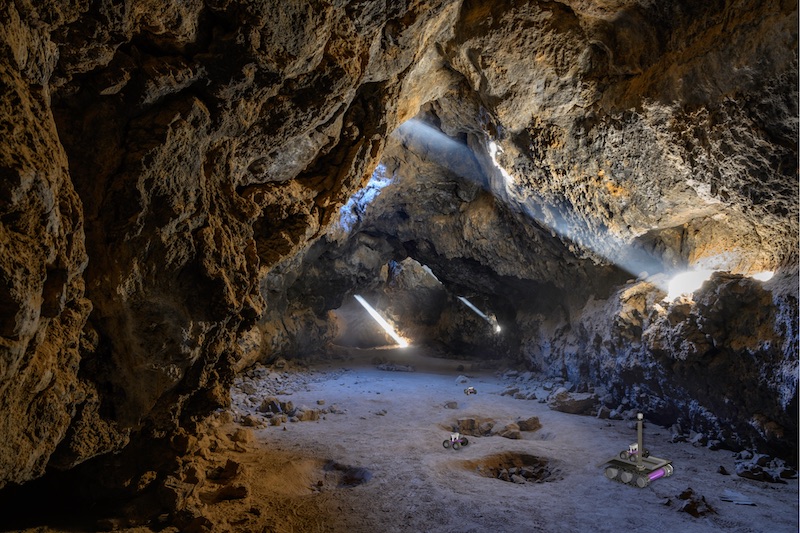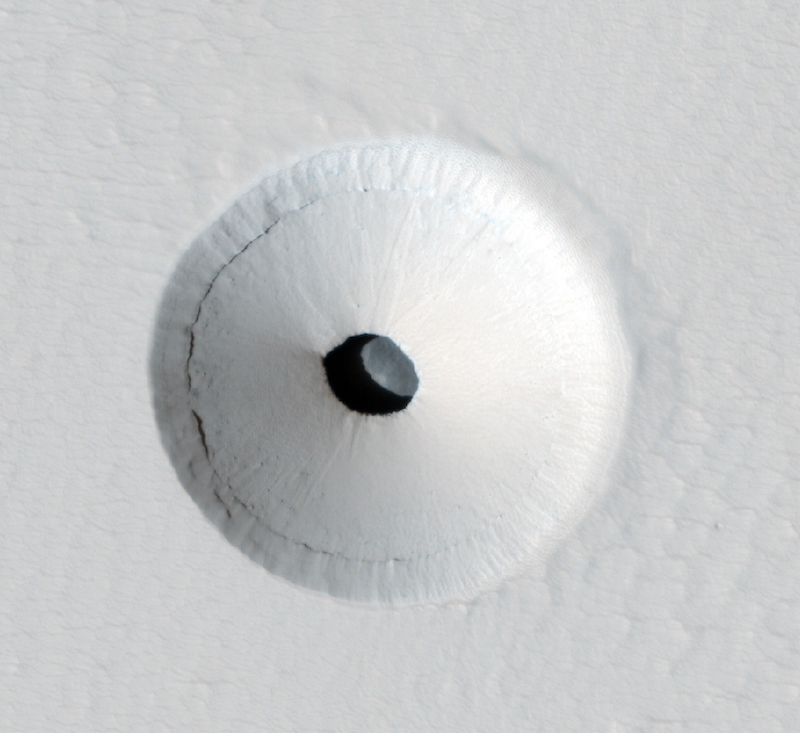Now Reading: Are water-carved caves on Mars hiding alien life?
-
01
Are water-carved caves on Mars hiding alien life?
Are water-carved caves on Mars hiding alien life?


- Mars has caves, just as Earth does. The ones found so far are thought to be lava tubes formed by flowing magma.
- Now 8 newly-discovered caves appear to have been carved by water. Researchers in China found them using data from NASA’s Mars missions.
- The caves might have been – or could be still – a habitat for microscopic life. The caves would offer some protection from the harsh environment on Mars’ surface.
Caves on Mars
If there’s life on Mars today, scientists think it’s likely underground. We know that Mars has caves, discovered by orbiters, but most found so far are lava-tubes, created by flowing molten lava. But this month (November 12, 2025), researchers in China said they’ve found the first caves on Mars potentially created by water dissolving rock. These are called karst caves. The caves are eight pits in the Hebrus Valles region of Mars. Could such caves be homes for life, now or in the past?
These water-carved caves do offer an intriguing possibility for life. The water, although long gone now, would have increased the chances of habitability. Plus, the caves themselves would help protect any organisms – likely microscopic – from dust storms, extreme temperature changes and radiation from the sun.
The new peer-reviewed findings were published in The Astrophysical Journal Letters on October 30, 2025.

1st known water-carved caves on Mars?
The researchers identified eight likely water-carved caves (karst caves) in Hebrus Valles, a north-western region on Mars. They are visible in images taken by Mars orbiters. The pits are deep and circular. But they have no raised rims or debris around them, however, as impact craters do. Caves like these with openings on generally flat terrain are also called skylights.
Intriguingly, the researchers said that these caves appear to be carved by water, not lava as is the case with lava tubes. As the research team wrote in the paper:
These skylights are interpreted as the first known potential karstic caves on Mars, representing collapse entrances formed through the dissolution of water-soluble lithology, defining a new cave-forming class distinct from all previously reported volcanic and tectonic skylights.
The clues came from the fact that the rocks around the cave openings are composed of carbonates and sulfates. Water can easily dissolve these softer kinds of rocks. To determine the composition, the team used data from the Thermal Emission Spectrometer (TES) instrument onboard NASA’s Mars Global Surveyor, which ended its mission in 2006. In addition, other high-resolution images from NASA’s Mars Reconnaissance Orbiter were also used to create 3D models of the caves.
Interestingly, these revealed that their shapes are consistent with collapse from water erosion, not lava or tectonic disturbances.

How karst caves are formed
So, how do these caves form? They are common on Earth, where water dissolves soluble rock, like limestone or gypsum. The water erodes the rock, creating cracks underground. Eventually, the cracks grow large enough to become caves.
On Mars, however, the rocks would most likely be carbonates and sulfates, but the process is similar.

In addition, scientists have also found caves on the moon. In this case, ancient magma is most likely responsible for creating the subsurface voids, or lava tubes. Future astronauts might be able to use such caves for shelter and to build crewed bases.
Future exploration
These eight caves – or others found in the future – would be ideal targets for future exploration, both robotic and human. With this in mind, researchers announced one such proposal back in 2023. Small autonomous rovers – inspired by the fairy tale Hansel and Gretel – would drop high-tech “breadcrumbs” to find their way in the caves. How cool is that? Exploring Martian caves or similar subsurface environments would be exciting … what might we find?
Bottom line: Researchers in China have discovered the first water-carved caves on Mars. Known as karst caves, they could provide a protective habitat for possible life.
Read more: Exploring Mars caves, leaving ‘breadcrumbs’
Read more: Moon caves and pits are a comfy 63 degrees
The post Are water-carved caves on Mars hiding alien life? first appeared on EarthSky.
Stay Informed With the Latest & Most Important News
Previous Post
Next Post
-
 012024 in Review: Highlights from NASA in Silicon Valley
012024 in Review: Highlights from NASA in Silicon Valley -
 02Panasonic Leica Summilux DG 15mm f/1.7 ASPH review
02Panasonic Leica Summilux DG 15mm f/1.7 ASPH review -
 03From Polymerization-Enabled Folding and Assembly to Chemical Evolution: Key Processes for Emergence of Functional Polymers in the Origin of Life
03From Polymerization-Enabled Folding and Assembly to Chemical Evolution: Key Processes for Emergence of Functional Polymers in the Origin of Life -
 04How New NASA, India Earth Satellite NISAR Will See Earth
04How New NASA, India Earth Satellite NISAR Will See Earth -
 05And Thus Begins A New Year For Life On Earth
05And Thus Begins A New Year For Life On Earth -
 06Astronomy Activation Ambassadors: A New Era
06Astronomy Activation Ambassadors: A New Era -
07SpaceX launch surge helps set new global launch record in 2024



















